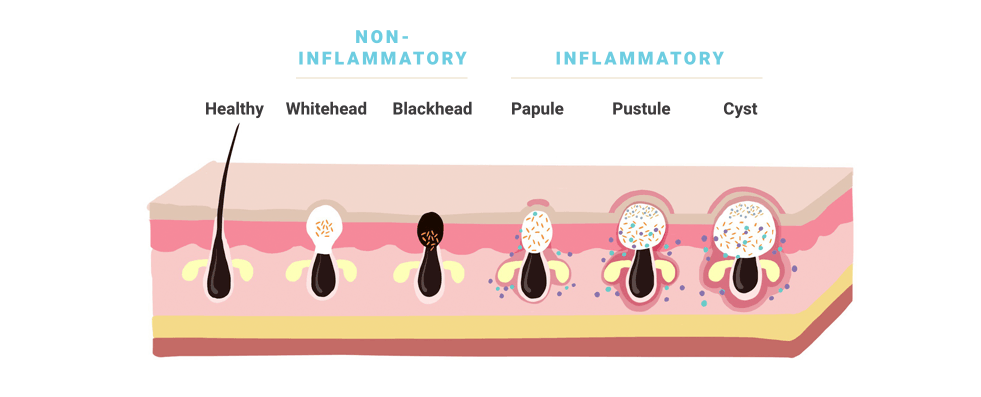WHAT KIND OF ACNE DO YOU HAVE?
Acne is categorized into two main groups:
Non-inflammatory Acne and Inflammatory Acne

Non-inflammatory Acne
Comedonal, non-inflammatory acne includes blackheads and whiteheads. Non-inflammatory acne also known as comedonal acne is a pattern of acne in which most lesions are open and/or closed comedones (black and white heads).Comedonal acne most commonly affects the forehead and chin.
Comedones arise when cells lining the sebaceous duct proliferate and there is increased sebum production. A comedone is formed by the debris blocking the sebaceous duct and hair follicle.
A whitehead is a closed clogged pore.Whiteheads are a form of non-inflammatory, comedonal, acne. A whitehead starts the same way as all acne pimples do. First, there is an overproduction of oil, the pore gets clogged by dead skin cells, oil and P. acnes bacteria. The area is not red or inflamed and there is no swelling associated with whiteheads.
A whitehead has a thin layer of skin covering the pore, trapping the plug of oil and dead skin cells beneath the pore’s surface. Like blackheads, whiteheads usually occur on the face but also may occur on the chest and torso.
While it is tempting, never squeeze a whitehead. Squeezing “pimples” may rupture the oil plug on the inside spreading bacteria, causing more diffuse inflammation and even creating a scar.
Non-inflammatory acne may be a little simpler to treat than inflammatory acne.
A blackhead starts the same way as all acne pimples do. First, there is an overproduction of oil, the pore gets clogged by dead skin cells, oil and P. acnes bacteria. The area is not red or inflamed and there is no swelling associated with blackheads.
A blackhead is a clogged pore that remains open. Since the clog is exposed to oxygen, it turns a dark color. A blackhead’s dark color is not caused by trapped dirt.
Blackheads usually localize in the “T-Zone” of the face (forehead, nose, and chin) but may also appear on the back, chest, arms and shoulders, wherever there is a great density of hair follicles.
Some products like moisturizers, sunblocks, makeup can clog pores. Use only “noncomedogenic” products for acne prone skin. “Noncomedogenic” products will not clog pores and potentially contribute to acne.
Inflammatory Acne
Inflammatory acne includes papules, pustules, nodules and deep cysts that may leave dark marks and in some cases scarring. It is crucial to treat inflammatory acne early, by a professional, to prevent any possibility of permanent scarring.
Inflammatory acne is characterized by red, swollen, deep and often painful pimples.
The wall of the pore ruptures, leaking bacteria and oil into the surrounding skin. Our immune system responds and sends in white blood cells to fight the infection, causing the surrounding area to become red, swollen, or inflamed. The breakout will be less severe if it happens closer to the skin surface. On the other hand, if the breakout occurs deep inside the pore, a cyst – a large, firm, bump deep inside the skin, may form.
There are different types of inflammatory acne depending on the size, redness, tenderness and potential to scar.
Papulas are a form of acne. These are pink or red, dome or flat shaped bumps, varying in size. There’s no visible fluid and they don’t contain pus.
Pustules are considered a moderate form of acne. Most types of acne include pustules. Pustules form when a plug deep inside the pore traps oil and bacteria, attracting white blood cells to fight the infection. Pustules have a yellow or white pus-filled center surrounded by inflammation. The greater the inflammation, the redder and larger the pustule will be.
Cystic acne is the most severe type of acne. Cystic acne presents itself as large, red, deep and painful breakouts, with cysts filled initially with blood, then with pus. These types of breakouts may form under the surface for weeks or even longer. Cystic acne tends to be hereditary and the most prone to scarring.